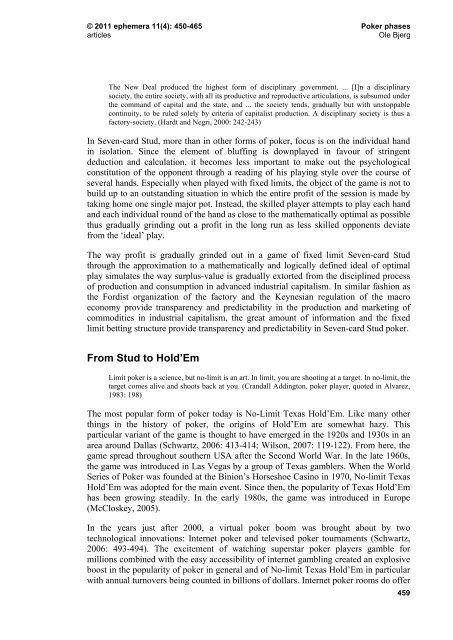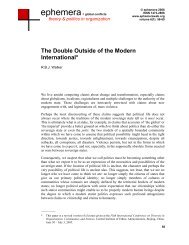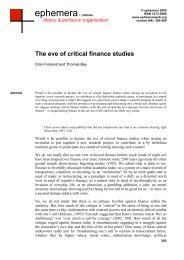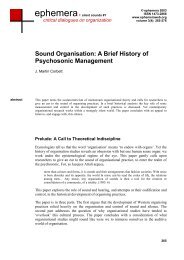Work, play and boredom - Ephemera
Work, play and boredom - Ephemera
Work, play and boredom - Ephemera
Create successful ePaper yourself
Turn your PDF publications into a flip-book with our unique Google optimized e-Paper software.
© 2011 ephemera 11(4): 450-465 Poker phases<br />
articles Ole Bjerg<br />
The New Deal produced the highest form of disciplinary government. ... [I]n a disciplinary<br />
society, the entire society, with all its productive <strong>and</strong> reproductive articulations, is subsumed under<br />
the comm<strong>and</strong> of capital <strong>and</strong> the state, <strong>and</strong> ... the society tends, gradually but with unstoppable<br />
continuity, to be ruled solely by criteria of capitalist production. A disciplinary society is thus a<br />
factory-society. (Hardt <strong>and</strong> Negri, 2000: 242-243)<br />
In Seven-card Stud, more than in other forms of poker, focus is on the individual h<strong>and</strong><br />
in isolation. Since the element of bluffing is down<strong>play</strong>ed in favour of stringent<br />
deduction <strong>and</strong> calculation, it becomes less important to make out the psychological<br />
constitution of the opponent through a reading of his <strong>play</strong>ing style over the course of<br />
several h<strong>and</strong>s. Especially when <strong>play</strong>ed with fixed limits, the object of the game is not to<br />
build up to an outst<strong>and</strong>ing situation in which the entire profit of the session is made by<br />
taking home one single major pot. Instead, the skilled <strong>play</strong>er attempts to <strong>play</strong> each h<strong>and</strong><br />
<strong>and</strong> each individual round of the h<strong>and</strong> as close to the mathematically optimal as possible<br />
thus gradually grinding out a profit in the long run as less skilled opponents deviate<br />
from the ‘ideal’ <strong>play</strong>.<br />
The way profit is gradually grinded out in a game of fixed limit Seven-card Stud<br />
through the approximation to a mathematically <strong>and</strong> logically defined ideal of optimal<br />
<strong>play</strong> simulates the way surplus-value is gradually extorted from the disciplined process<br />
of production <strong>and</strong> consumption in advanced industrial capitalism. In similar fashion as<br />
the Fordist organization of the factory <strong>and</strong> the Keynesian regulation of the macro<br />
economy provide transparency <strong>and</strong> predictability in the production <strong>and</strong> marketing of<br />
commodities in industrial capitalism, the great amount of information <strong>and</strong> the fixed<br />
limit betting structure provide transparency <strong>and</strong> predictability in Seven-card Stud poker.<br />
From Stud to Hold’Em<br />
Limit poker is a science, but no-limit is an art. In limit, you are shooting at a target. In no-limit, the<br />
target comes alive <strong>and</strong> shoots back at you. (Cr<strong>and</strong>all Addington, poker <strong>play</strong>er, quoted in Alvarez,<br />
1983: 198)<br />
The most popular form of poker today is No-Limit Texas Hold’Em. Like many other<br />
things in the history of poker, the origins of Hold’Em are somewhat hazy. This<br />
particular variant of the game is thought to have emerged in the 1920s <strong>and</strong> 1930s in an<br />
area around Dallas (Schwartz, 2006: 413-414; Wilson, 2007: 119-122). From here, the<br />
game spread throughout southern USA after the Second World War. In the late 1960s,<br />
the game was introduced in Las Vegas by a group of Texas gamblers. When the World<br />
Series of Poker was founded at the Binion’s Horseshoe Casino in 1970, No-limit Texas<br />
Hold’Em was adopted for the main event. Since then, the popularity of Texas Hold’Em<br />
has been growing steadily. In the early 1980s, the game was introduced in Europe<br />
(McCloskey, 2005).<br />
In the years just after 2000, a virtual poker boom was brought about by two<br />
technological innovations: Internet poker <strong>and</strong> televised poker tournaments (Schwartz,<br />
2006: 493-494). The excitement of watching superstar poker <strong>play</strong>ers gamble for<br />
millions combined with the easy accessibility of internet gambling created an explosive<br />
boost in the popularity of poker in general <strong>and</strong> of No-limit Texas Hold’Em in particular<br />
with annual turnovers being counted in billions of dollars. Internet poker rooms do offer<br />
459








